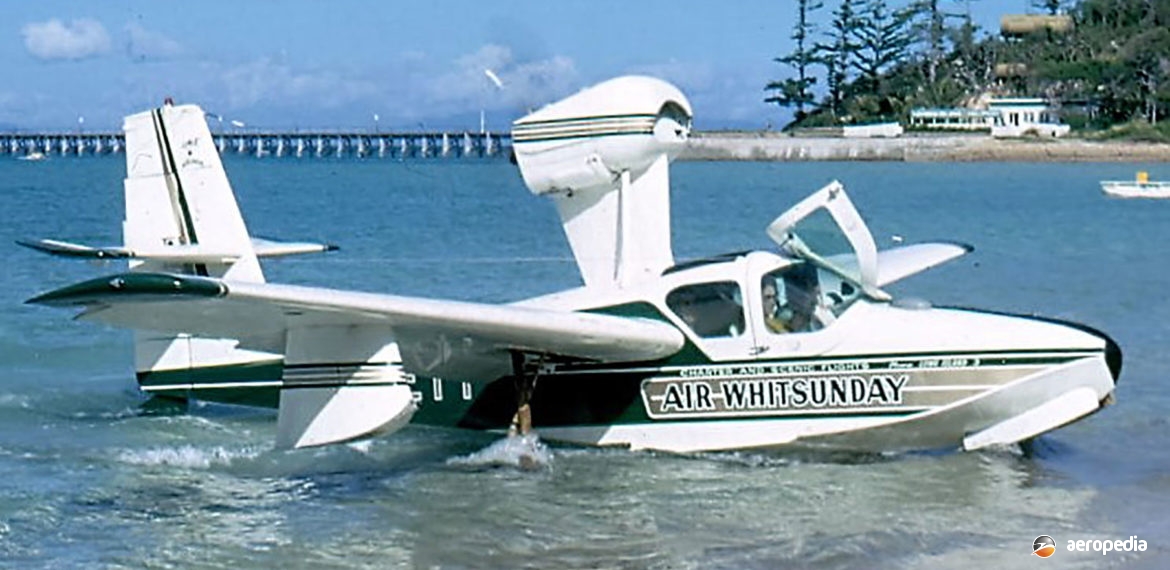Photograph:
Lake LA-4 Buccaneer VH-ETY (c/n 529) at Hayman Island, QLD in July 1973 (David C Eyre)
Country of origin:
United States of America
Description:
Four-seat light amphibious flying-boat
Power Plant:
One 149 kw (200 hp) Lycoming IO-360-A1A four-cylinder horizontally-opposed air-cooled engine
Specifications:
- Wingspan: 11.58 m (38 ft)
- Length: 7.6 m (24 ft 11 in)
- Height: 2.84 m (9 ft 4 in)
- Wing area: 15.79 m² (170 sq ft)
- Max speed: 241 km/h (150 mph)
- Cruising speed: 211 km/h (131 mph)
- Stalling speed: 72 km/h (45 mph)
- Initial rate of climb: 365 m/min (1,200 ft/min)
- Service ceiling: 4,481 m (14,700 ft)
- Max range at economical cruising speed: 1,327 km (825 miles)
- Range at 75% power at 2,438 m (8,000 ft): 1,046 km (650 miles)
- Fuel capacity (with reserve): 204 litres (45 Imp gals)
- Empty weight: 705 kg (1,555 lb)
- Loaded weight: 1,220 kg (2,690 lb)
History:
The Colonial C-1 Skimmer was built by the Colonial Aircraft Corporation in the USA, with the prototype being flown for the first time on 17 July 1948. This three-seat amphibian was powered by a 93 kw (125 hp) Lycoming O-290-D engine, and received its type certification on 19 September 1955. Development trials revealed the prototype was a little under-powered so production aircraft were fitted with the 112 kw (150 hp) Lycoming O-320-A1A engine.
In 1957 the C-1 was joined on the production line by the Model C-2, fitted with a 134 kw (180 hp) Lycoming O-360-A1A engine. An improved version, known as the Skimmer IV, appeared later. In 1959 manufacturing rights were obtained by the Lake Aircraft Corporation, and later again, in 1962, Consolidated Aeronautics merged with Lake Aircraft Corporation of Sanford, Maine, resulting in Lake Aircraft being operated as a division.
The prototype LA-4 was flown for the first time in November 1959, and the first production aircraft was flown in April 1960. These were similar to the C-2 but the wings had been extended by 1.22 m (4 ft), 0.3 m (1 ft) was added to the length of the ailerons, and the bow was 0.43 m (1 ft 5 in) longer. Also, the wing-to-fuselage attachment was revised, the gross weight was increased, and structural reinforcement was added.
Type approval was received on 1 June 1960. Whereas the LA-4 was fitted with the 134 kw (180 hp) Lycoming engine, an improved version appeared in 1970 with the 149 kw (200 hp) Lycoming fuel-injected engine. The earlier model became known as the LA-4-180, and the new model was the LA-4-200 Buccaneer. The latter had the maximum speed increased by 22 km/h (14 mph), the cruising speed by 19 km/h (12 mph), and the loaded weight by 91 kg (200 lb). Standard fuel capacity was 151.4 litres (33.3 Imp gals) but auxiliary tanks could be fitted in the wing-floats, 28 litres (6 Imp gals) in each, thus increasing capacity to 208 litres (45 Imp gals).
The Buccaneer was a cantilever shoulder-wing monoplane. The wing had duralumin leading and trailing-edge torsion boxes separated by a single duralumin main spar, all-metal ailerons and hydraulically operated slotted flaps. The fuselage was a single-step all-metal structure with a double-sealed boat hull. A hydraulically retractable tricycle-type undercarriage was fitted.
The type has proved popular in this region, with some 40-odd examples having been operated in Australia, and six in New Zealand, some privately owned and others used on tourist work in Queensland and Tasmania. One of the largest operators of the type was Air Whitsunday, which operated charter and tourist flights from Airlie Beach on the Great Barrier Reef in the 1980s. Its fleet included VH-ETY (c/n 529), VH-EJX (c/n 596), VH-EDV (c/n 489), and VH-EJZ (c/n694), later being replaced by two Grumman Mallards. Another was operated by the “Royal Provincial Air Force of the Hutt River” in Western Australia in 1974. One, VH-ETC (c/n 582) flown by Harvey Prior and Alex McKenzie for Lake Aircraft Sales of Blacktown, NSW made an eight day circuit of Australia in 1975.
Only a few examples survive as private aircraft and these have been occasionally seen at water-based aviation events such as the Seaplane Pilots Association fly-ins at the old RAAF flying boat base at Rathmines, NSW. One example has been retired, restored and placed on display at the Queensland Air Museum at Caloundra.

